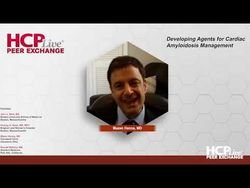Management of Cardiac Amyloidosis - Episode 9
Poor Toleration: AL and ATTR Treatment Modification
Transcript: John L. Berk, MD: I’d like to have a few controversial words about some other topics for cardiomyopathy. For standard and starting point, someone is referred to you, they’re thought to have a nonamyloidogenic cardiomyopathy. They’re on ACE [angiotensin-converting enzyme] inhibitors after load reduction, they’re on β-blockers, they’re doing really poorly. They’re on diuretics, naturally. Is there a modification that you always consider and are they effective, Dr Witteles?
Ronald Witteles, MD: And we’re talking about in a patient where now a diagnosis of amyloidosis has been made, correct?
John L. Berk, MD: Yes.
Ronald Witteles, MD: I would say it is actually probably quite different between AL [light-chain amyloidosis] and transthyretin amyloidosis [ATTR]. Patients with AL amyloidosis do particularly poorly with standard neurohormonal therapy, and this is likely for a number of reasons. Number 1 is that they tend to have quite profound postural symptoms, quite profound orthostasis. This happens a lot from autonomic dysfunction, plus patients with amyloidosis, in general, will often have small cavities because of the increased wall thickness. They can often have chronotropic incompetence or frank heart block. So β-blockers and RAAS [renin-angiotensin-aldosterone system] inhibitors tend to be very poorly tolerated, and I would say it would be the very rare exception that we would want a patient with AL on any of those agents, with the exception of occasionally needing something like a β-blocker for rate control of somebody with rapid atrial fibrillation that we can’t otherwise control. But, in general, the neurohormonal antagonists should not be used for patients with AL.
For patients with transthyretin, it’s a little trickier I’d say, particularly for those with wild-type transthyretin. This is generally an older patient population with often quite significant baseline hypertension just because of their demographics—being an older male population. Certainly, we don’t like to leave them frankly hypertensive. So if somebody is tolerating their neurohormonal antagonists, in that case I won’t tend to take them off. But there is definitely a low threshold if you’re flirting with low blood pressures to pull them off. We certainly have no reason to believe that neurohormonal antagonism helps with amyloid cardiomyopathies as it does for most other forms of at least systolic heart failure.
Akshay S. Desai, MD, MPH: What about Digoxin?
Ronald Witteles, MD: Digoxin is traditionally thought of as contraindicated in patients with amyloid cardiomyopathies because of concerns it aligns amyloid fibrils and leads to local toxicities, even with normal therapeutic serum levels. I think most of us have found that particularly true for transthyretin amyloidosis, that overt Dig toxicity with using a low-level Dig when needed for rate control is generally OK. I would not personally use it otherwise, that would be the only indication I would use it for. And in patients with AL, I think I would be even more cautious. But I’m curious, Akshay and Maz, what your views are on them.
Mazen Hanna, MD: We’ve run into the same problem. We’ve had patients with AL cardiac amyloidosis who have had rapid AFib [atrial fibrillation] along with severe heart failure. You read the older article that Martha Skinner wrote, where they ground up fibrils that were AL and AA, in this case not ATTR, and found that Dig avidly bound those fibrils, and then imputing that: “Hey, there must be a higher local concentration,” and in conjunction with some cases of sudden cardiac death, it was dogma: Digoxin shouldn’t be given. I remember they used to give a lot higher doses then.
Martha Grogan and her Mayo Clinic colleagues published an article—Muchtar is the first author—in the Amyloid Journal, looking at their experience with Digoxin in patients with AL, specifically AL amyloidosis, and found a rate of adverse events, I think it was 10% to 12%. But their conclusion was with careful dosing and monitoring of serum levels and monitoring, that if you really are in a corner where you need rate control, and you can’t use β-blockers or diltiazem, that you have to evaluate the risks versus the benefits.
And with TTR [transthyretin], I agree with Ron, same thing. We have just submitted a manuscript of about 69 patients who were on Digoxin—over half had TTR—and came up with similar adverse event rates, but we didn’t see any deaths attributed to Digoxin. So, for me, the take-home message is I would be cautious. I wouldn’t use it unless you really needed it, and I would use it with lower doses with clear monitoring. But to say it’s absolutely contraindicated, I think that’s dogma.
Akshay S. Desai, MD, MPH: I agree. I think I brought it up mainly for that reason. I think that it is important, though, that we think about aggressive management of atrial fibrillation in these patients. It’s very poorly tolerated, particularly at high rates. Some of the traditional therapies, for the same reasons that Ron mentioned, are poorly tolerated for heart failure. Aggressive rate control of atrial fibrillation with AV [atrioventricular] nodal agents is often not well tolerated in patients with amyloid heart disease. I think we often do reach for older agents like Digoxin in extreme circumstances, but then I think we also need to think more aggressively about strategies for restoration of sinus rhythm, where that’s possible. We could talk a little bit about whether there’s a role for more aggressive strategies like pulmonary vein isolation. I think most of us have concerns in patients with advanced amyloid about the likelihood of success of those strategies.
But I think we even run to strategies like AV junction ablation a little bit earlier in this population, where we’re really struggling with adequate rate control, understanding that that leaves patients dependent on pacing systems. So, I think that management of AF is a real problem in this population—certainly thromboembolism and those risks are amplified and underscore the need for anticoagulation.
Transcript Edited for Clarity



